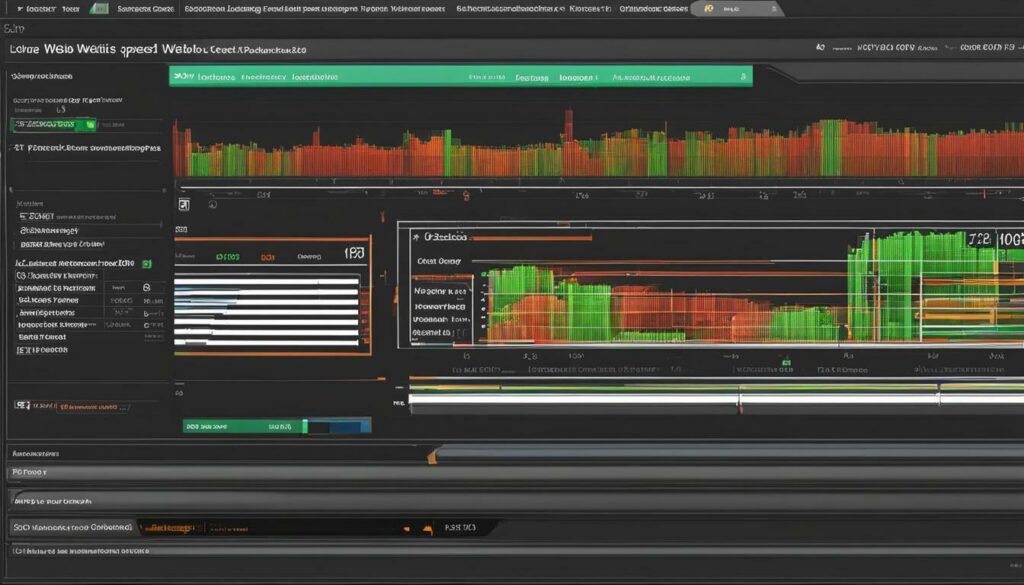Boost Your Online Experience with Web Speed Check and ensure faster and smoother browsing by accurately measuring your website’s performance. In today’s digital age, website speed plays a crucial role in user satisfaction and engagement. Slow-loading websites not only frustrate visitors but also lead to higher bounce rates and lower conversions.
Fortunately, you can take control of your website’s speed by conducting a website performance test. With the help of web speed check tools, you can identify any bottlenecks or issues that might be slowing down your website. By optimizing your website’s speed, you can enhance user experience, increase page views, and improve search engine rankings.
Main information:
- Web speed check is essential for improving user experience and increasing website performance.
- Slow-loading websites can lead to higher bounce rates and lower conversions.
- Website performance tests help identify and resolve issues that impact speed.
- Optimizing website speed enhances user experience, increases page views, and improves search engine rankings.
Understanding the Impact of Internet Speed
Your internet speed plays a crucial role in determining your online activities, impacting factors such as buffering times, download speeds, and video quality. A slow connection can be frustrating, leading to lengthy buffering times, sluggish downloads, and poor video quality. On the other hand, a fast and reliable internet connection enables seamless streaming of high-quality videos without interruptions.
According to research, 47% of users expect a website to load in 2 seconds or less, and 40% will abandon a site that takes more than 3 seconds to load. This highlights the importance of internet speed in providing a smooth and enjoyable online experience.
Slow internet speed not only affects user experience but also has implications for search engine optimization (SEO). Search engines prioritize fast-loading websites, as they provide a better user experience. In fact, Google considers site speed as one of the ranking factors for search results. Therefore, optimizing your internet speed is not only essential for a seamless online experience but also for improving your website’s visibility and online presence.
Research has shown that someone is likely to click away from your site if it takes more than 400 milliseconds — a literal blink of an eye — to load.
The Impact of Internet Speed on Online Activities
The impact of internet speed on online activities is significant. A slow internet connection can result in frustration and hinder various tasks, such as:
- Browsing: Slow internet speed leads to slower page loading times, making it time-consuming and frustrating to browse websites.
- Streaming: Buffering issues, frequent pauses, and reduced video quality can occur when streaming content with a slow internet connection.
- Downloading: Slow internet speed prolongs the time it takes to download files, leading to delays in accessing important documents or media files.
- Online Gaming: Slow internet speed can cause lag and delays in online gaming, affecting the overall gaming experience.
- Video Conferencing: Video calls and conferences may suffer from poor video and audio quality, interruptions, and latency issues with a slow internet connection.

It is evident that internet speed directly affects the quality and efficiency of various online activities. For a seamless online experience, it is essential to ensure a fast and reliable internet connection.
| Internet Speed | Online Activities |
|---|---|
| Fast and reliable | Smooth browsing, seamless streaming, quick downloads, uninterrupted gaming, high-quality video conferencing. |
| Slow and unstable | Slow page loading, buffering issues, prolonged downloads, lag in online gaming, poor video and audio quality in video conferencing. |
By understanding the impact of internet speed on your online activities, you can prioritize optimizing and improving your internet connection. In the following sections of this article, we will explore various tools, tips, and tricks to boost your internet speed and enhance your overall online experience.
Types of Internet Speed Test Tools
When it comes to testing your internet speed, you have two options: browser-based speed test tools and mobile apps, each with its own set of advantages and disadvantages.
Browser-Based Speed Test Tools:
Browser-based tools operate by sending requests from your web browser to a server located elsewhere on the internet. The server then measures the time it takes for data to travel back to your device.
Advantages:
- No installation required, making them easily accessible.
- Compatible with various devices, as they run directly in web browsers.
Disadvantages:
- Results may not be entirely accurate due to limitations imposed by browsers.
- Results can vary based on your location and distance from the servers.
Popular examples of browser-based tools include WifiTest.net, Speedtest.net, Fast.com, and Google Fiber Speed Test.
Mobile Apps:
Mobile apps function similarly to browser-based tools, but they use different protocols to establish connections between devices and servers.
Advantages:
- Offer advanced features such as server selection, allowing for more precise testing.
- Tend to provide more accurate results compared to browser-based tools.
Disadvantages:
- Limited to mobile devices.
- Not all apps may be available for free.
Well-known mobile app-based tools include Ookla Speedtest, Netflix’s fast.com app, and OpenSignal.
When choosing between browser-based speed test tools and mobile apps, consider your device compatibility, accuracy requirements, and any additional features you may need. Ultimately, both options can help you measure your internet speed and diagnose any potential issues.
Web Speed Check Comparison
| Browser-Based Speed Test Tools | Mobile Apps |
|---|---|
| Easily accessible | Offers advanced features |
| Compatible with various devices | Provides more accurate results |
| Results may not be entirely accurate | Limited to mobile devices |
| Results can vary based on location | Not all apps may be available for free |
By understanding the different types of internet speed test tools available, you can choose the one that best suits your needs. Whether you opt for a browser-based tool or a mobile app, the key is to regularly test your internet speed to ensure optimal performance for your online activities.
Read also out article related to “high speed dedicated servers”
Benefits of Using an Web Speed Check Tool
Using an internet speed test tool offers several benefits, including determining your current internet speed, verifying if your ISP delivers the promised speeds, and diagnosing potential network or ISP issues. These benefits are essential for optimizing your online experience and ensuring that you are getting the most out of your internet connection.
Determining Your Current Internet Speed:
An internet speed test tool allows you to accurately measure your network’s download and upload speeds. This information is valuable for troubleshooting connectivity issues and verifying if your internet service provider (ISP) is delivering the speeds they have promised. By knowing your current internet speed, you can assess if it meets your needs for activities like streaming videos, downloading files, or online gaming.
Verifying if your ISP Delivers the Promised Speeds:
When you subscribe to a specific plan from your ISP, it is crucial to ensure that they are delivering the speeds as advertised. An internet speed test tool can help you identify any discrepancies between the promised speeds and the actual speeds being provided. By regularly testing your internet speed, you can hold your ISP accountable and ensure that you are getting the service you are paying for.
Diagnosing Potential Network or ISP Issues:
If you experience slow internet connection or inconsistencies in your online activities, an internet speed test can help pinpoint whether the problem lies with your network or your ISP. By running tests at different times and comparing the results, you can gather data to troubleshoot potential issues. This information can be valuable when contacting your ISP’s customer support, as it provides evidence of any ongoing network or ISP issues.
This comprehensive table summarizes the benefits of using an internet speed test tool:
| Benefits of Using an Internet Speed Test Tool |
|---|
| Determining Your Current Internet Speed |
| Verifying if your ISP Delivers the Promised Speeds |
| Diagnosing Potential Network or ISP Issues |
By utilizing an internet speed test tool, you can have a better understanding of your internet connection, ensure that you are getting the speeds you are paying for, and troubleshoot any potential network or ISP issues. This knowledge empowers you to make informed decisions about your internet service and optimize your online experience. So, take advantage of the available tools and regularly test your internet speed to ensure a fast and reliable connection.
Quote:
“Using an internet speed test tool is essential for optimizing your online experience and ensuring that you are getting the most out of your internet connection.”
Performing an Web Speed Check
Performing an internet speed test is a straightforward process that involves connecting your device to the network, choosing a suitable testing tool, running the test, and analyzing the results. By conducting regular speed tests, you can ensure that your internet connection is performing optimally and identify any potential issues that may be affecting your browsing experience.
Before running the test, make sure your device is connected to either Wi-Fi or an Ethernet cable to ensure accurate results. A stable connection is essential for reliable speed testing. Once connected, you can choose from a variety of testing tools to assess your internet speed.
Popular browser-based speed test tools include Speedtest.net, Fast.com, and Google Fiber Speed Test. These tools operate by sending requests from your web browser to a server located elsewhere on the internet. The server then measures the time it takes for data to travel back to your device, providing you with information about your download and upload speeds as well as latency (ping) values.
If you prefer mobile app-based speed tests, options like Ookla Speedtest, Netflix’s fast.com app, and OpenSignal are widely used. These apps offer advanced features such as server selection, allowing for more precise testing. Mobile app-based tools tend to provide more accurate results compared to browser-based tools.
Connecting Device to Network
Before running an internet speed test, ensure that your device is connected to the network either via Wi-Fi or an Ethernet cable.
Choosing a Testing Tool
There are various browser-based and mobile app-based internet speed test tools available. Choose a suitable tool based on your preference and device compatibility. Some popular browser-based tools include Speedtest.net, Fast.com, and Google Fiber Speed Test. For mobile app-based tools, options like Ookla Speedtest and Netflix’s fast.com app are widely used.
Running the Test
Once your device is connected and you have selected a testing tool, you can initiate the speed test. Click the “Start” button or follow the instructions provided by the tool to begin the test. The test will measure your download and upload speeds, as well as latency (ping) values, and may take a few seconds to complete.
Analyzing the Results
After the test is complete, you will be presented with the results, which typically include your download and upload speeds in Mbps (megabits per second) and latency values in milliseconds. Analyze these results to determine if your internet speed meets your expectations and if any issues need to be addressed. If your speeds are significantly lower than what you are paying for or experiencing frequent disruptions, you may want to contact your internet service provider (ISP) to investigate further.
| Browser-Based Speed Test Tools | Mobile App-Based Speed Test Tools |
|---|---|
| – Speedtest.net | – Ookla Speedtest |
| – Fast.com | – Netflix’s fast.com app |
| – Google Fiber Speed Test | – OpenSignal |

Performing regular internet speed tests is essential for understanding and optimizing your internet connection’s speed. By utilizing browser-based or mobile app-based tools, you can accurately measure your internet speed, identify any potential issues, and ensure optimal performance for your online activities.
Factors such as the distance from your router, obstructions, the number of connected devices, and the quality of service provided by your internet service provider (ISP) can all impact your internet speed. By staying aware of these factors and regularly testing your internet speed, you can address any issues that may arise, troubleshoot connectivity problems, and ensure a smooth and enjoyable online experience.
Factors Affecting Your Internet Speed
Several factors can affect your internet speed, including the distance from your router or Wi-Fi source, obstructions in the signal path, the number of devices connected, and the quality of service provided by your ISP.
Distance from Your Router or Wi-Fi Source:
The distance between your device and the router or Wi-Fi source can impact your internet speed. The farther you are from the source, the weaker the signal strength, which can result in slower speeds. To mitigate this, ensure that your device is within a reasonable range of the router or access point.
Obstructions in the Signal Path:
Obstacles like walls, furniture, or other electronic devices can interfere with the Wi-Fi signal, leading to reduced speeds. To improve your internet speed, position your device and router in an open area with minimal obstructions. You may also consider using Wi-Fi range extenders or mesh networks to enhance coverage in larger spaces.
Number of Devices Connected:
The number of devices connected to your network can impact your internet speed. When multiple devices are using the same network simultaneously, bandwidth is shared among them, resulting in slower speeds. To improve your internet speed, limit the number of devices connected at the same time or consider upgrading to a higher bandwidth plan.
Quality of Service Provided by Your ISP:
The quality of service provided by your internet service provider (ISP) can significantly impact your internet speed. Factors such as network congestion, bandwidth limitations, and technical issues within the ISP’s infrastructure can affect your connection. If you consistently experience slow internet speeds, contact your ISP to troubleshoot the issue or consider switching to a more reliable provider.

In summary, several factors can affect your internet speed, including the distance from your router or Wi-Fi source, obstructions in the signal path, the number of devices connected, and the quality of service provided by your ISP. By considering these factors and implementing appropriate measures, such as optimizing your network setup and choosing a reliable ISP, you can improve your internet speed and enhance your online experience.
Tips to Boost Your Website Speed and Improve User Experience
Improve your website speed and enhance user experience with these practical tips that include optimizing images, minimizing HTTP requests, leveraging browser caching, using a content delivery network (CDN), minimizing plugin usage, reducing server response time, keeping your website updated, and regularly monitoring and testing website speed.
Optimize your images
One of the most common causes of slow website speed is large image file sizes. Optimizing your images can significantly improve your website’s loading time. Use free tools like Kraken.io or TinyPNG to compress your images without compromising quality. By reducing the file size of your images, you can enhance both user experience and search engine rankings.
Minimize HTTP requests
Reducing the number of HTTP requests your website makes can greatly improve its loading speed. This can be achieved by combining multiple stylesheets and scripts into one, and using CSS sprites to combine multiple images into a single file. By minimizing HTTP requests, you simplify your website’s code and optimize its performance.
Leverage browser caching
Utilize browser caching to improve your website’s speed and performance. By setting expiration dates for your static resources (such as images, stylesheets, and scripts), you enable the user’s browser to store these resources in its cache. This reduces the number of requests your website makes and improves its loading time for returning visitors.
Use a content delivery network (CDN)

Implementing a content delivery network (CDN) can significantly boost your website’s loading speed, especially for users located in different geographic regions. CDNs cache and deliver content from servers closest to the user’s location, reducing latency and improving overall performance. Popular CDN services like Cloudflare and Akamai offer caching, security, and analytics features to further enhance your website’s speed and user experience.
Minimize the use of plugins
While plugins add functionality to your website, they can also slow it down. Limit the number of plugins you use and choose lightweight alternatives when possible. Deactivate or uninstall any plugins that are no longer necessary. By minimizing the use of plugins, you reduce the amount of additional code on your website and improve its overall speed and performance.
Reduce server response time
Server response time can significantly impact your website’s speed. Choose a high-quality web hosting provider and optimize your server configuration to ensure faster response times. Minimize the use of server-side scripts and consider using a CDN to distribute traffic effectively. By reducing server response time, you can enhance user experience and improve website performance.
Keep your website updated
Maintaining your website’s software and technology up to date is essential for optimal speed and performance. Regularly update your CMS, plugins, themes, and any other software your website relies on. Keeping everything updated helps improve speed, security, and reliability.
Regularly monitor and test your website speed

Regularly monitoring and testing your website speed allows you to identify and address any issues promptly. Use tools such as Google’s PageSpeed Insights or GTmetrix to assess your website’s speed and receive recommendations for improvement. By regularly monitoring and testing your website speed, you can ensure optimal performance and deliver a seamless user experience.
| Tip | Description |
|---|---|
| Optimize Images | Compress image file sizes without compromising quality to improve loading time |
| Minimize HTTP Requests | Combine stylesheets and scripts, use CSS sprites, and reduce requests for faster loading |
| Leverage Browser Caching | Set expiration dates for static resources to improve loading time for returning visitors |
| Use a CDN | Utilize a CDN to deliver content from servers closest to users’ locations for faster performance |
| Minimize Plugin Usage | Limit the number of plugins and choose lightweight alternatives to optimize speed |
| Reduce Server Response Time | Optimize server configuration and minimize server-side scripts to improve response time |
| Keep Your Website Updated | Maintain software updates for improved speed, security, and reliability |
| Regularly Monitor and Test Website Speed | Use tools to assess speed, identify issues, and optimize performance for seamless user experience |
Implement these tips to boost your website speed and provide an exceptional user experience. By optimizing images, minimizing HTTP requests, leveraging browser caching, using a CDN, minimizing plugin usage, reducing server response time, keeping your website updated, and regularly monitoring and testing website speed, you can enhance your website’s performance and achieve online success.
Conclusion
Enhance user experience, improve search engine optimization, and achieve online success by optimizing your website speed and ensuring a fast and responsive browsing experience.
Website speed plays a crucial role in attracting and retaining visitors. Slow-loading websites can lead to frustration and prompt users to abandon the site in search of faster alternatives. Research shows that users expect a website to load in 2 seconds or less, and delays of just a few seconds can significantly impact user satisfaction and engagement.
Furthermore, search engines like Google consider website speed as a ranking factor. Websites that load quickly are more likely to appear higher in search engine results, attracting more organic traffic and increasing visibility. Thus, optimizing your website speed not only improves user experience but also enhances your search engine optimization (SEO) efforts.
To optimize website speed, there are several actionable steps you can take. Start by optimizing your images, compressing them without compromising quality. Reduce the number of HTTP requests by combining stylesheets, scripts, and leveraging CSS sprites. Leverage browser caching to store static resources and improve loading speed for returning visitors. Consider using a content delivery network (CDN) to deliver content from the nearest server to users, reducing latency and improving overall website speed.
Other strategies include minimizing the use of plugins, which can add unnecessary code and slow down your website, and reducing server response time by choosing a high-quality hosting provider and optimizing server configuration. Keeping your website updated with the latest software and technology is crucial for maintaining speed, security, and reliability. Lastly, regularly monitoring and testing your website speed using tools like Google’s PageSpeed Insights or GTmetrix can help identify areas for improvement and ensure optimal performance.
By implementing these tips, you can optimize your website speed and provide a seamless and enjoyable browsing experience for your users. An optimized website not only improves user satisfaction but also contributes to better search engine rankings, increased organic traffic, and ultimately, online success.
